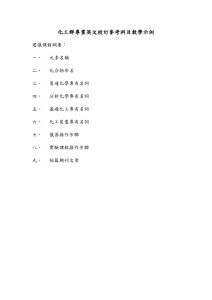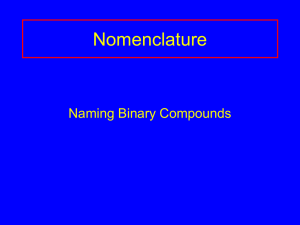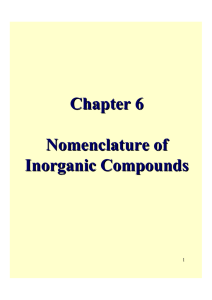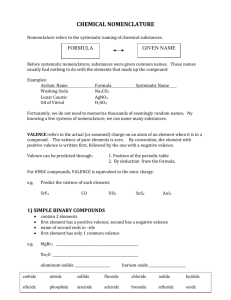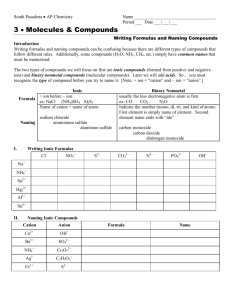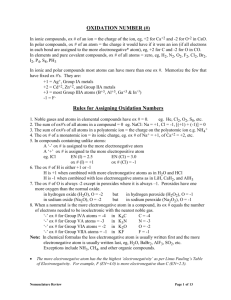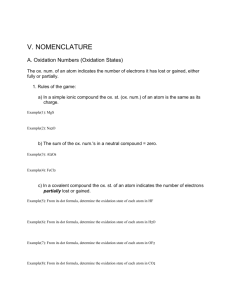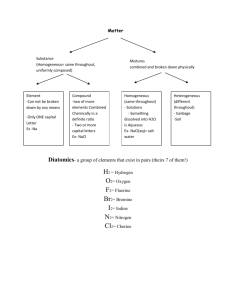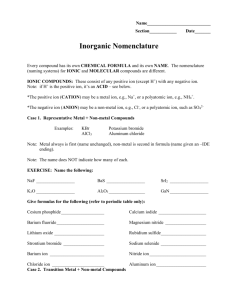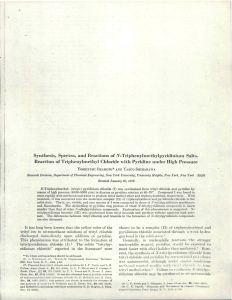Naming of Compounds:
advertisement
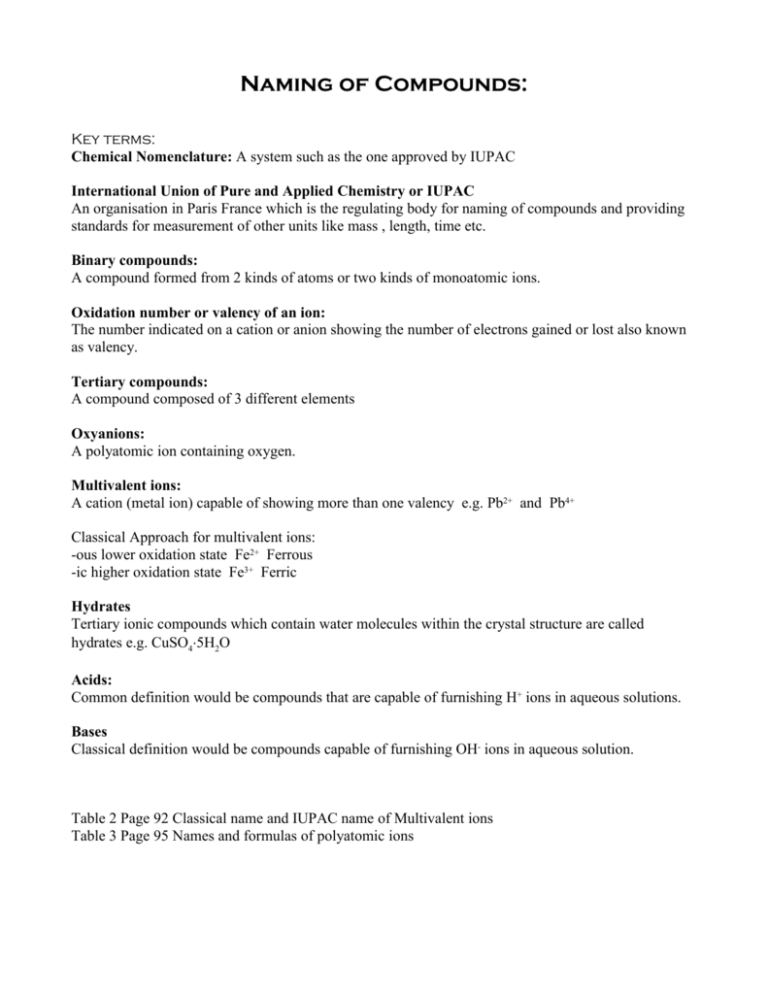
Naming of Compounds: Key terms: Chemical Nomenclature: A system such as the one approved by IUPAC International Union of Pure and Applied Chemistry or IUPAC An organisation in Paris France which is the regulating body for naming of compounds and providing standards for measurement of other units like mass , length, time etc. Binary compounds: A compound formed from 2 kinds of atoms or two kinds of monoatomic ions. Oxidation number or valency of an ion: The number indicated on a cation or anion showing the number of electrons gained or lost also known as valency. Tertiary compounds: A compound composed of 3 different elements Oxyanions: A polyatomic ion containing oxygen. Multivalent ions: A cation (metal ion) capable of showing more than one valency e.g. Pb2+ and Pb4+ Classical Approach for multivalent ions: -ous lower oxidation state Fe2+ Ferrous -ic higher oxidation state Fe3+ Ferric Hydrates Tertiary ionic compounds which contain water molecules within the crystal structure are called hydrates e.g. CuSO4⋅5H2O Acids: Common definition would be compounds that are capable of furnishing H+ ions in aqueous solutions. Bases Classical definition would be compounds capable of furnishing OH- ions in aqueous solution. Table 2 Page 92 Classical name and IUPAC name of Multivalent ions Table 3 Page 95 Names and formulas of polyatomic ions Binary Compounds: q Metals first followed by non-metals q For multivalent ions indicate oxidation number or ionic charge in brackets using roman numerals Tertiary Compounds: q Polyatomic ions are a group of covalently bonded atoms which has a net charge may be positive or negative. q Metals first followed by poly atomic ions that are negatively charged q Poly atomic cat ion first followed by poly atomic negative ion Polyatomic oxyanions of halogens: General Formula XOXO2 - XO3XO4- Name Cl Br Hypohalite Hypochlorite Halite ClOChlorite Halate ClO2Chlorate Perhalate ClO3Perchlorate I ClO24Ending -hyposulphite -sulphite -sulphate -per sulphate Number of Oxygen atoms 2 3 4 5 Formula of ion SO22SO32SO42SO52- Penta 5 Octa 8 Hypo is low less oxygen Hyper is high more oxygen Di Tri 2 3 Tetra 4 Hexa 6 Hepta 7 Nona 9 Deca 10 Hydrates: Name of the compound followed by the number of molecules of water of crystallization using the above terminology. Compound CuSO4⋅5H2O Na2SO4⋅10 H2O MgSO4⋅7H2O CaSO4⋅2H2O Al2O3 ⋅2H2O IUPAC Name Acids: Binary Acids: Ending Aqueous hydrogen --------Formula HF (aq) HCl (aq) HBr (aq) HI (aq) H2S (aq) Classical or Trivial Name Hydrofluoric acid Hydrochloric acid Hydrobromic acid Hydroiodic acid Hydrosulfuric acid Oxy acids of Chlorine: Formula IUPAC HClO (aq) Aqueous hydrogen hypochlorite HClO2 (aq) Aqueous hydrogen chlorite HClO3 (aq) Aqueous hydrogen chlorate HClO4 (aq) Aqueous hydrogen perchlorate Hypo is low less oxygen Hyper is high more oxygen Acids dissolved in water are aqueous hydrogen---Bases: Hydroxides Bases dissolved in water are aqueous metal hydroxide…. IUPAC Classical Name Hypochlorous acid Chlorous acid Chloric acid Perchloric acid Chemical Formula LiNO3 Chemical Name Chemical Name Lithium Chlorate Ag2SO4 Silver Nitrite KNO2 Iron (II) Chlorite Fe2(SO3)3 Potassium Nitrate Be(IO)2 Iron (III) Hypochlorite MnSO4 Zinc Carbonate NaIO2 Lead (II) Perchlorate Ni2(SO3)3 Beryllium Sulfite Mg(IO3)2 Nickel (III) Iodate Hg3(PO4)2 Magnesium Sulfate Ca(BrO)2 Lead (IV) Periodate Pb3(PO4)4 Calcium Phosphite Ba(BrO2)2 Nickel (II) Hypoiodite Sn3(PO3)2 Barium Phosphate LiBrO3 Gold (I) Iodite Ag3PO5 Lithium Perphosphate KBrO4 Silver Phosphate FeCO3 Gold (III) Hypoiodite Be(IO4)2 Potassium Phosphite MnSO4 Copper (II) Periodate NaClO Zinc Sulfate NiSO3 Copper (I) Iodate Mg(ClO2)2 Beryllium Sulfite HgSO4 Manganese(II) Perchlorate Ca(ClO3)2 Magnesium Carbonate PbCO3 Ba(ClO4)2 Manganese (IV) Hypochlorite Calcium Nitrate Sn(SO4)2 Tin (II) Chlorite ZnCO3 Barium Nitrite AuPO4 Tin (IV) Chlorate AgNO3 Tin (II) Chloride Chemical Formula AlPO3 Sodium Phosphide Ba(ClO2)2 Antimony (V) Sulphide FeSO3 Hydrogen Iodide KIO3 Potassium Nitride H3PO2 Arsenic (III) Oxide Sn(SO4)2 Mercury (I) Oxide As(NO3)3 Potassium Chloride NaCH3COO Zinc Phosphide Cr(NO3)3 Iron (III) Fluoride HgClO Lead (IV) Oxide CuSO4 Phosphorus (V) Chloride (NH4)2CO3 Zinc Chloride Fe3(PO3)2 Carbon Monoxide Zn(ClO)2 Carbon Dioxide SbPO3 Sulfur Dioxide Cu(ClO4)2 Sulfur Trioxide KBrO4 Hydrogen Peroxide (NH4)2SO4 Carbon Tetrachloride K3PO2 Iron (II) Sulfide HIO3 Barium Chloride Na2O2 Tin (IV) Oxide K2O2 Arsenic (III) Hydride NaClO4 Phosphorus (III) Oxide As(NO3)5 Arsenic (III) Hydride Sb2(SO3)3 Phosphorus (III) Oxide Zn3(PO4)2 Arsenic (V) Sulphide Ag2SO4 Gold (I) Bromide Au(ClO3)3 Magnesium Iodide Mg(BrO4)2 Beryllium Chloride Ca3(PO2)2 Boron Hydride Al2(SO3)3 Aluminum Oxide MnSO3 Antimony (III) Iodide Pb(IO2)2 Cuprous Sulfide Cu(BrO4)2 Hydrogen oxide H2SO3 Silver Chloride Fe2(SO3)3 Lithium Sulfide KClO4 Barium Sulfide Na2SO4 Strontium Phosphide HgClO2 Ferric Iodide Ca(CH3COO)2 Stannic Chloride Ag2CO3 Plumbous Nitride Sr(NO3)2 Antimony (III) Carbide (NH4)3PO3 Hydrogen Sulfide Ag3N Ammonia Cu3N2 Plumbic Oxide LiCl Copper (II) Chloride PbO2 Silicon Dioxide Na2S Chromium (III) Chloride SnBr2 Nickel (III)Fluoride CaBr2 Beryllium Oxide MnI4 Carbon Disulphide MgI2 Manganese (II) Oxide HgF Phosphorus Trioxide BeF2 Cobalt (II) Sulfide Au2O3 Carbon Tetrafluoride BaO Ferrous Sulphide NiS Nitrogen Hydride ZnS Cupric Oxide FeO Mercury (II) Carbide AlN Phosphorus (V) Oxide CuCl2 Antimony (V) Nitride BF3 Nickel (II) Bromide PbCl2 Chlorine Oxide AgIO2 Chromium (II) Sulphide Zn3(PO3)2 Boron Sulfide Fe(BrO4)2 Aluminum Nitride Ca(ClO4)2 Sodium Oxide LiIO Stannous Fluoride SnSO3 Copper (I) Sulfide Mg3(PO2)2 Silver Sulfide As(IO4)5 Lithium Carbide Pb(OH)2 Calcium Phosphide Ba(ClO)2 Strontium Bromide HgNO3 Magnesium Phosphide K2SO3 Sodium Phosphite (NH4)3PO4 Iron (II) Perchlorate H2CO3 Zinc Sulfite As2S3 Cupric Chlorite Al(IO)3 Calcium Hypochlorite NaIO2 Tin (IV) Chlorite Pb(OH)4 Copper (II) Hypobromite HBrO2 Manganic Hypophosphite Mg3(PO3)2 Zinc Carbonate Sb2O5 Arsenic Nitrite Ag(CH3COO) Calcium Acetate SnF2 Antimonous Chlorite Cu(ClO2)2 Silver Acetate Mn(IO4)4 Tin (II) Chlorite Mg(ClO)2 Sodium Sulphate Na2SO3 Mercury (II) Perchlorate Ca(IO3)2 Calcium Hypophosphite Al(BrO4)3 Barium Sulfite Be3(PO3)2 Plumbic Phosphite Sn(OH)2 Mercury (II) Nitrate Hg(IO)2 Potassium Iodate KClO Aluminum Hypophosphite NH4NO3 Ferric Nitrate CaF2 Sodium Nitride ZnBr2 Lead (II) Perchlorate CO2 Antimony (V) Sulfite SnCl2 Aluminum Sulfate CrF2 Magnesium Carbonate CoO Iron (II) Hypochlorite Mg3N2 Permanganic Acid AsBr3 Ammonium Sulphite CuO Zinc Iodate AlBr3 Gold (III) Nitrate FrH Copper(I)Hypophosphite OBr2 Manganous Sulphate CuCl Potassium Periodate MnO2 Magnesium Hypobromite NH3 Ammonium Acetate Cu3N2 Zinc Cyanide MnS2 Lithium Peroxide SO2 Aluminum Cyanide Formula Name Uses KMnO4 Solution reduces odours MgO Used in Toothpaste MgSO4.7H2O Epsom salts – Laxative NaCl Road salt; water softner NaClO3 Toothpaste, mouthwashes, antiseptics NaF Toothpaste – helps prevent cavities NaHSO4 Toilet bowl cleaner NaI Iodized salt to prevent goitre NaNO2 Curing Meat NaNO3 Curing Meat NaOH Drain Cleaner; pulp & paper industry Na3PO4 Jello Pudding; cheese spread Na2S Kraft process for making paper Na2SO4 Glass making NH4Cl Cough Syrups (NH4)2CO3 Smelling Salts PF3 Insecticide and rodenticide PbO Glass making SnF2 Toothpaste – helps prevent cavities SO2 Bleaching; preservation ZnCO3 Suntan Lotion ZnO Skin Lotions; White Glue Formula Name Uses Al(OH)3 Antacid tablets CaCO3 Antacid tablets Na2CO3 Antacid tablets BaS Fluorescent Paint BaSO4 To X-ray the stomach and intestines AlCl3 Deodorant protects against wetness CaCl2 Road Salt Ca(CN)2 Extraction of gold from its ores CaO Removes warts Ca3P2 Emergency signal lights Cl2 Bleaching ClO2 Bleaching CS2 Used in making cellophane & rayon CuSO4 Dyeing leather; fungicide; algicide H2SO4 Silver tarnish cleaner HCl(aq) Silver tarnish cleaner H3PO4 Denture cleaners HCOOH Kettle scale remover HF(aq) Frosts light bulbs KAl(SO4)2.12H2O (alum) Dyes, glue, cement, tanning KClO3 Matches, explosives K2Cr2O7.2H2O Tanning Leather 1. How does an ionic bond differ from a covalent bond? 2. Briefly summarise and explain the properties of ionic and covalent compounds 3. Explain why electrical conductivity is a suitable test for ionic compounds 4. What are intra molecular and inter molecular bonding? Give suitable examples and explain 5. The most common oxides of period three are as follows Na2O, MgO, Al2O3, SiO2, P2O5, SO2, Cl2O, q Classify the compounds as either ionic or molecular q Use electron dot diagrams or Lewis structures to show the formation of each compound q What properties would expect to observe in the properties of each of the compound? 6. Explain why NH3 is pyramidal where as BF3 is planar? 7. What is the shape of the water molecule? 8. Design an experiment using known solvents to study the difference in the intermolecular forces and predict your observations using the structure of the molecule. 9. Which of the following molecules would be polar and which of them would have only polar bonds. 10. H2O, NH3, BF3, BeCl2, CCl4, CHCl3, CO2, 11. The dipole moments of the following molecules are not zero how would you explain it? SO2, HF, NF3, 12. Explain bonding in the following molecules using lewis structures 13. PCl3, NH4Cl, PCl5, ClO4-, N2H2, OF2, H2O2
